|
In 2011 the community structure of canton Glarus was reorganized into
three administrative communities:
- Glarus
Nord including the original communities Bilten, Niederurnen, Oberurnen,
Näfels, Mollis, Filzbach, Obstalden and Mühlehorn
- Glarus
including the original communities Netstal, Glarus, Riedern and Ennenda
- Glarus
Süd including the original communities Mitlödi, Sool, Schwändi,
Schwanden, Nidfurn, Haslen, Leuggelbach, Luchsingen, Hätzingen,
Betschwanden, Diesbach, Rüti, Linthal, Braunwald, Engi, Matt, and Elm
The map at right is taken from
Wikimedia Commons under the terms of the
GNU Free Documentation License.
|
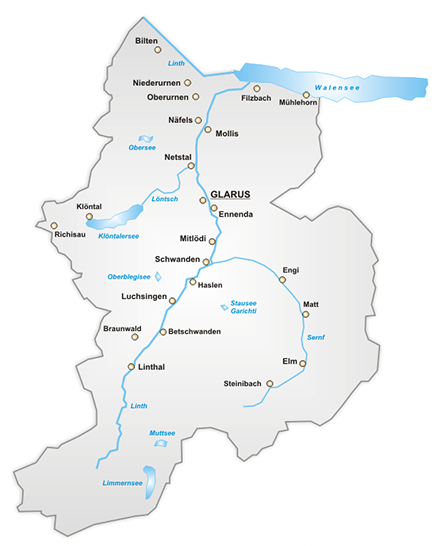
|
top of page
Demographic Development of the Canton of Glarus (PDF)
top of page
This text is based on a history written by Peter Jehli,
and was translated by Sue Wolf.
St. Fridolin
Fridolin was an Irish monk, who, according to the legend,
should have lived at the time of the Frankish king Clovis, around
about 500 A.D. Many learned people doubt whether Fridolin had
really lived. According to tradition he (according to an
apparition of St. Hilarius) founded the cloister, Säckingen on
the Rhine.
The land of Glarus belonged to the cloister for a long time
through a donation; this is the likely reason why Fridolin became
the cantonal patron.
The land of Glarus originates
- The actual colonization of the valleys began a few
centuries before Christ. Celts and Raetians left behind
traces of simple farming activity.
- Around the birth of Christ the Romans established estates
and smaller fortified installations in our valley.
- In the 6th and 7th centuries the Alemanni
immigrated into our valley.
- In the 8th century the Carolingians assumed
power, exercised jurisdiction in our canton and collected
taxes. Since about 750 a quarter of the land
belonged as a donation to the Säckingen cloister.
- Around 820 the name Glarona was first
mentioned in the legend of Felix and Regula.
- 1264 - Rudolf of Habsburg becomes the Holy Roman
Empire official over Glarus.
- The opposition of the Glarner population was awakened
under the increasing pressure of the Habsburgs. Although
they should have participated on the Habsburg's side of
it, the Glarners in 1315 stayed away from the Morgarten
war.
- 1351 - the Zurichers and the Forest Cantons
occupied Glarus.
- On June 4, 1352 the Glarners sealed a first
federation, which was never recognized by the Habsburgs.
Since it awarded the confederation more rights than the
Glarners, this signified to them that it was a so-called inferior
or bad federation.
- In July 1386 (Sempacher War) the Glarners
breached the Oberwindegg castle near Niederurnen.
Filzbach [a commune] received the land rights. With help
of the confederation the town of Weesen is captured.
- On March 11, 1387 the first Popular Assembly
[Landsgemeinde] in Glarus took place. The Glarners
declared themselves free and drew up the first
constitution.
- On the night of February 21 and 22, 1388 the people of the
Glarner army of occupation in Weesen were murdered by troops loyal
to the Habsburgs (image at right).
- On April 9, 1388 there was a battle at Näfels
(image at right). The Habsburg army was crushingly
defeated by the Glarners, with the help of a handful of confederates.
After that Glarus was considered a confederated canton of
equal status.
- 1419 - the market town of Glarus became the
capital.
- As late as 1473 the Glarners now also received
formal equality in the improved federation.
- 1476 - participation of the Glarners in the
battles against Karl den Kühnen [Karl the Bold].
- From 1506 till 1516, Ulrich Zwingli, the later
Reformer, is pastor in Glarus.
- Between 1525 and 1529 the Reformation was
introduced into the majority of the Glarner communes.
Mainly the wealthier northern communes remained true to
the old faith, however.
- 1548 - the first game-shooting reserve of
Switzerland was established : the Freiberg Kärpf.
- 1623 - cantonal agreement brings
denominationally separate Popular Assemblies.
- 1798 - the French conquered Switzerland. The
defeat of the Glarners near Wollerau. Glarner
land was occupied.
- 1799 - the French, Austrians and Russians fought
on Glarner soil.
- 1803 - the land of Glarus became Canton
Glarus by Napoleon's constitution.
- 1811 - the inauguration of the Escher canal.
- 1822 - the inauguration of the Linth canal.
- 1837 - new cantonal constitution and
elimination of the denominational land partition.
- 1861 - the burning of Glarus (image at right).
- 1864 - the first industrial law of
Switzerland was passed in Glarus.
- 1881 - landslide of Elm (image at right).
- 1887 - the Popular Assembly gave itself a new
cantonal constitution.
- 1899 - the "Klausenstrasse"
between Linthal and Altdof, Uri was inaugurated.
- 1916 - the first old people's and surviving
dependent's insurance for Switzerland was introduced
in Glarus.
- 1972 - the first Popular Assembly with the participation
of women took place (image at right).
Reports about the most recent Assemblies may be viewed
in
German with short abstracts in English.
|
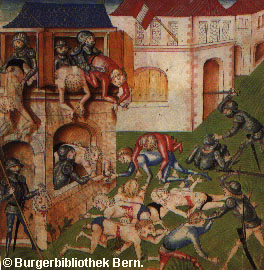 Weesen Murder Night, 1388
Weesen Murder Night, 1388
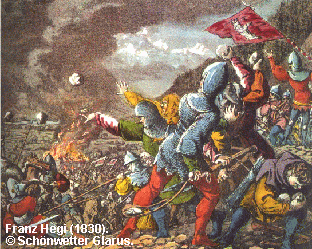 Battle at Näfels, 1388
Battle at Näfels, 1388
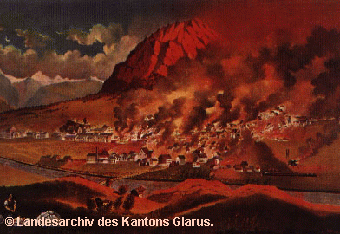 Burning of Glarus, 1861
Burning of Glarus, 1861
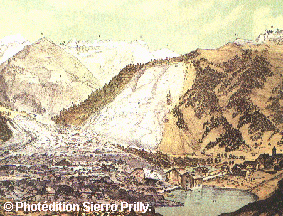 Landslide of Elm, 1881
Landslide of Elm, 1881
 First Popular Assembly with women, 1972
First Popular Assembly with women, 1972
|
top of page
The local genealogical societies are
Genealogisch-Heraldische Gesellschaft Zürich
and (for some parts)
Rätische Vereinigung für Familienforschung
If you have questions about genealogical research in Canton
Glarus you may contact
Bear in mind that these volunteers are amateur
genealogists, answering your questions in their spare time. Please give them
sufficient time to respond.
You can discuss your questions with others interested in canton
Glarus on the
Genealogieforum Glarus.
The archive is open to visitors to read; in order to be able to respond or start
a new thread, registration (free of charge)
is required. When posting, please keep in mind that only topics related to Glarus
should be placed here; for topics related to other regions, navigate from the
homepage to the
appropriate forum or to the
forum for Switzerland in general.
top of page
The
Landesarchiv (State Archive) has specific family genealogies available
back to 1595 that they will share with interested descendants for a fee.
Postgasse 29
Postfach 515
CH - 8750 Glarus
phone: +41 55 646 63 01
fax: +41 55 646 63 13
email: landesarchiv@gl.ch
Register of libraries and archives in Canton Glarus
top of page
top of page
- Canton Glarus, Switzerland Genealogy
- Sources
- On the History of the Glarner Families,
Particularly Those of the Sernf Valley by Gottfried Heer (1920)
Families included: Altmann, Bäbler, Baumgartner, Beglinger, Blumer,
Bräm, Disch, Elmer, Freitag, Giger, Hämmerli, Hauser, Hefti, Kubli,
Luchsinger, Madutz, Marti, Rhyner, Schneider, Schuler, Speich,
Stauffacher, Wirth, Wohlwend, Wyss, Zentner
- On the History of the Citizen Families of
Engi and Their Development by Martin Baumgartner (1923)
Families included: Altmann, Baumgartner, Blumer, Bräm, Giger, Hämmerli,
Luchsinger, Marti, Norder, Wyss
-
Glarner Families Worldwide by Patrick Wild
-
Geneal-Tree on Geneal-Forum
- Family pages
top of page
top of page



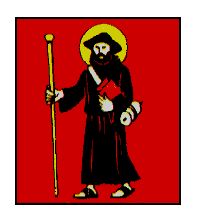
 Weesen Murder Night, 1388
Weesen Murder Night, 1388 Battle at Näfels, 1388
Battle at Näfels, 1388 Burning of Glarus, 1861
Burning of Glarus, 1861 Landslide of Elm, 1881
Landslide of Elm, 1881 First Popular Assembly with women, 1972
First Popular Assembly with women, 1972